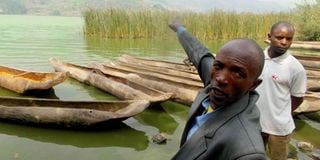Lake Mulehe turns green, Kisoro leaders ask govt to intervene

Inspection. Mr Stephen Ngambeki (left), the chairman of Lake Mulehe Fishermen Association and a journalist inspect Lake Mulehe whose waters turned green two months ago. PHOTO BY ROBERT MUHEREZA
What you need to know:
- Cause. Preliminary investigations indicate that waters turned green because of high temperatures in the lake.
Kisoro.
Lake Mulehe in Kisoro District has turned green, leaving hundreds of residents who depend on the water source, scared.
The Nyundo Sub-county councillor, Mr Izdol Tumusiime, said the water colour changed two months ago and dead fish is floating on the lake.
“Hundreds of people living around Lake Mulehe have been using the water for domestic purposes but for now, they fear using it because of the green colour,” Mr Tumusiime said on Monday.
He added: “We are worried that if what caused death of fish and water to turn green is not quickly handled, it may affect Lake Mutanda since the two lakes are connected by River Mucha.”
Mr Tumusiime was on Monday speaking at the district belated World Environment Day celebrations held on the shores of Lake Mulehe in Nyundo.
Speaking to Daily Monitor in an interview, Mr Stephen Ngambeki, the chairman for Lake Mulehe Fishermen Association, said death of fish is threatening livelihood of those who depend fishing business.
Residents worried
Residents used to make a catch of at least 100 fish from the lake daily.
Mr Ngambekyi said fishermen also fear that the green water might even affect their skin.
“We are also worried that the water might affect our skin as we lay fishing nets. The central government should investigate the cause,” Mr Ngambeki said.
The district natural resources officer, Mr Vincent Mudanga, said: “Preliminary investigations show that waters of Lake Mulehe turned green because of high temperatures in the lake.”
The high temperatures triggered by dry season, he said, forced the green plants and other debris on the bottom of the lake to come on top.
A similar phenomenon, Mr Mudanga said happened in the same lake 15 years ago.
“We need to conserve the catchment of this lake; plant trees on hill tops and allow the degraded wetlands, river banks and lake shores to recover. We shall wait for the technical report detailing the dangers of the water turning green,” Mr Mudanga added.
The Kisoro District chairperson, Mr Abel Bizimana, however said there are claims that farming practices could have affected the lake.
“We heard rumours that spraying tea gardens with herbicides and pesticides on the farms around the Lake Mulehe could have caused the water to turn green. We expect a report from the technocrats to clarify such rumours,” Mr Bizimana noted.
The State minister for Environment, Dr Mary Gorreti Kitutu, who was the chief guest at the function said a technical team from the ministry will investigate the issue.
“I have already instructed the technocrats from my ministry to investigate the cause and come up with the best way forward,” Dr Kitutu revealed.
Environment conservation
Dr Kitutu appealed to the local leaders to sensitise residents on environmental conservation in order to avoid harsh climatic conditions such as prolonged drought and its resultant effects.
“Harsh climatic conditions occur as a result of people destroying the environment. Please always do your best in conserving the natural beauty of Kigezi,” she advised.
Dr Kitutu also urged leaders to educate the communities on family planning, arguing that population pressure is one of the causes of environmental degradation in Uganda.
The minister pledged to donate trees to be planted on bare hill tops and road reserves in the district as part of her campaign for for environment conservation.
The Resident District Commissioner, Mr Shafique Ssekandi, criticised charcoal makers and brick dealers over the massive deforestation in the area.
The district vice chairperson, Ms Rose Manirakiza, asked government to deploy police to enforce the conservation laws.
“Wetlands, river banks and lake shores in Kisoro District have been degraded and turned into crop gardens. Efforts by the district authorities to stop such illegal activities have not yielded much because of shortage of resources to carry out community sensitisation. We need environmental police to make conservation work easy,” Ms Manirakiza said.
The assistant commissioner of the Directorate of Water Resources Management at the Water ministry, Mr Albert Orijabo, said they have developed a management plan of Ruhezamyenda water catchment area where Lake Mulehe lies to reverse degradation. He appealed to both Kabale and Kisoro local governments to incorporate the activities of the management plan into their development plans for the protection of water and natural resources.
About the lake
Lake Mulehe is located 10kms from Kisoro Town along the Kisoro-Bwindi Rushaga gorilla trekking route.
It is surrounded by spectacular terraces farmed by the local community.
Some of the tourism attractions on Lake Mulehe include fishing, canoeing, birding, speed boats and the rich welcoming culture of the Bakimbiri, the residents.
Lake Mulehe is a natural lake that covers a surface area of two square kilometres and has an average depth of 14 metres.




